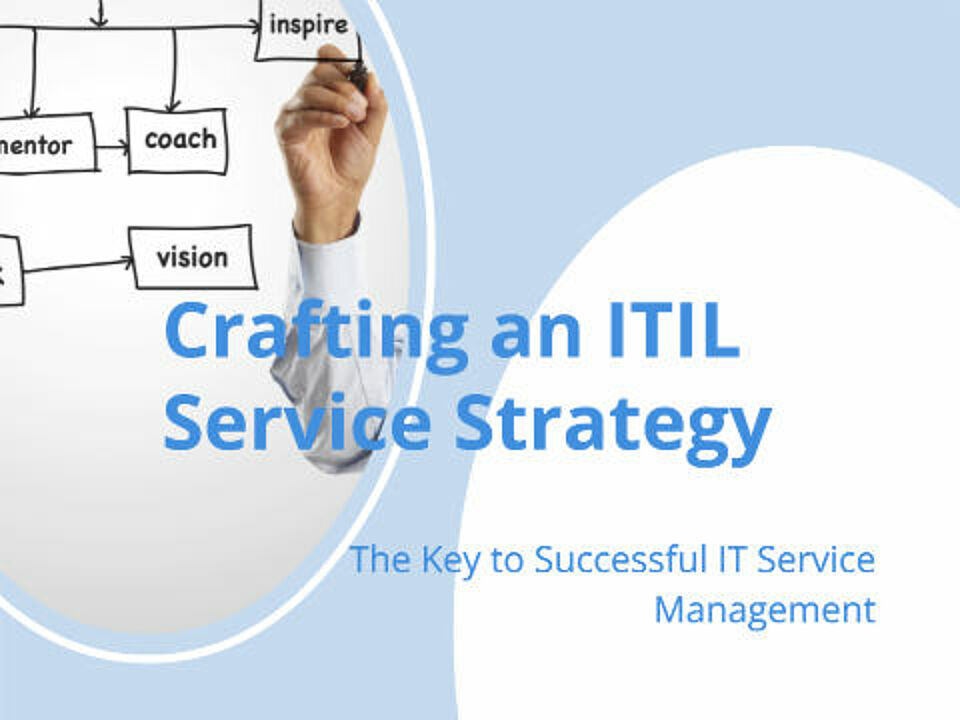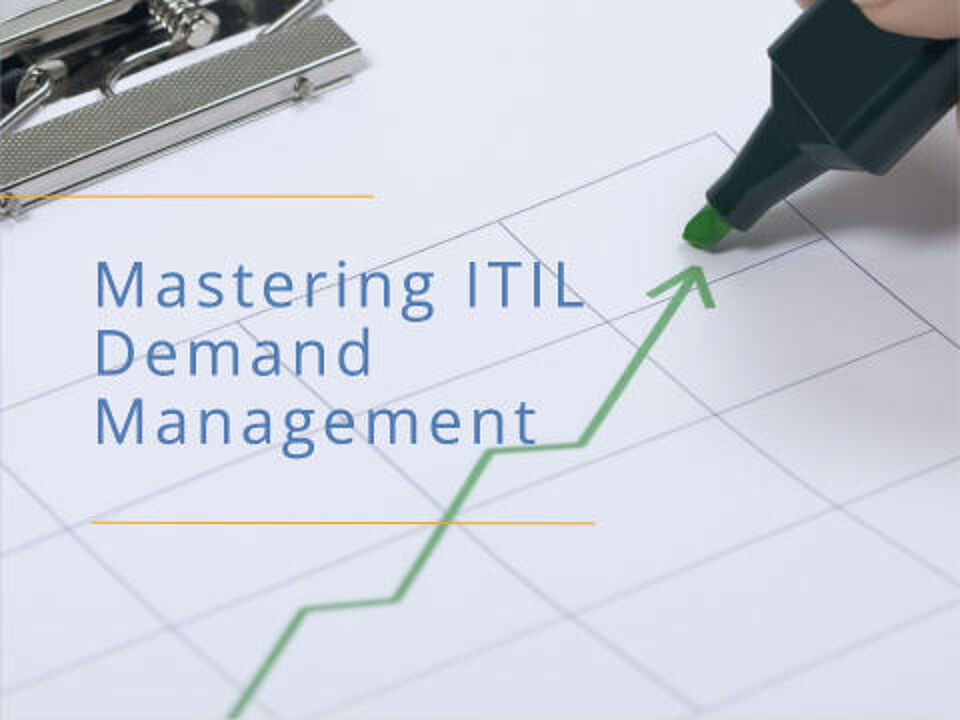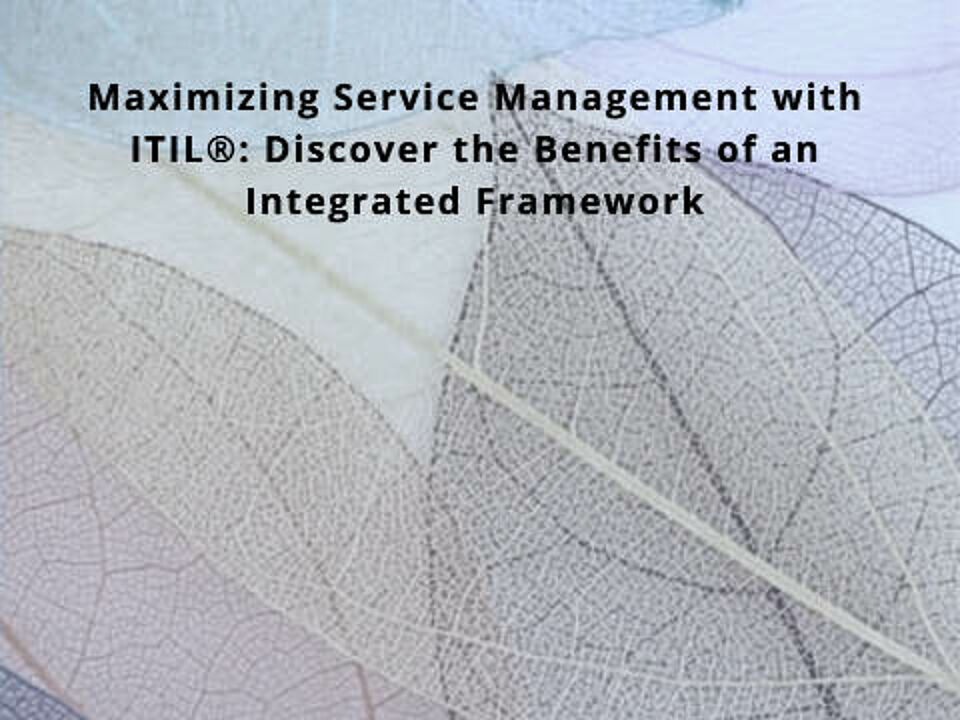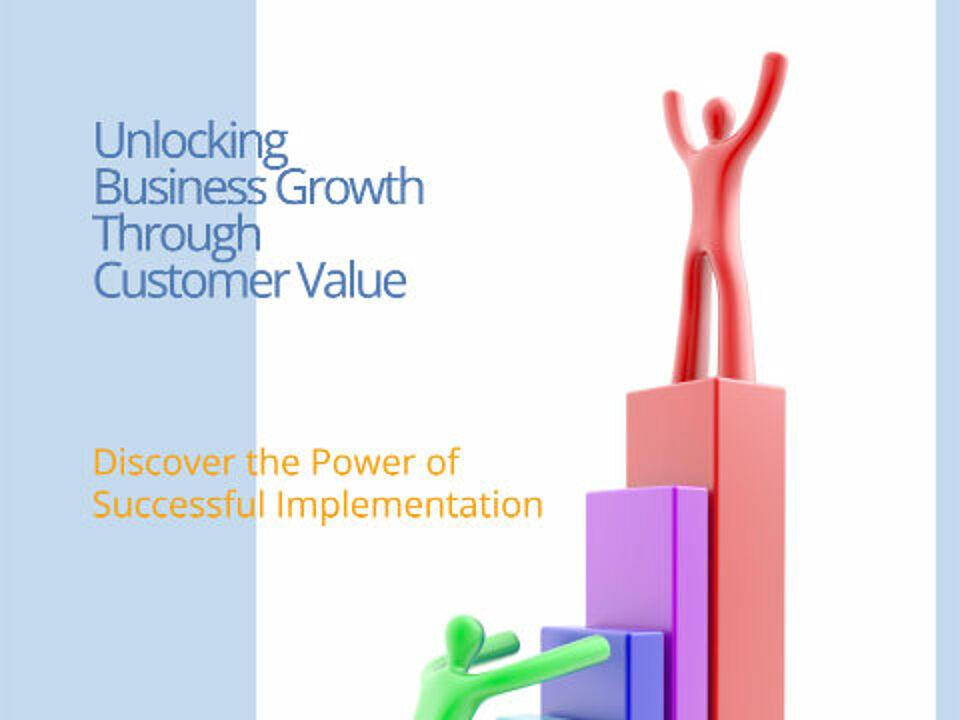
The ITIL® v3 service strategy is an approach that provides an effective IT strategy for implementing IT services. Before we take a closer look at the concept itself, first a brief explanation of ITIL: It is a collection of best practices for IT service management (ITSM) that help an organisation manage internally to successfully and effectively deliver IT services. Best practice is to be understood as a recommendation for best service.
It is one of five modules of the ITIL v3 process and defines the direction and perspective for the entire IT organisation. It plays a central role as it lays the foundation on which all other ITIL modules are built. Timing, relevance, profitability and accuracy of services are factors that are agreed and monitored here and later translated into concrete activities of the other modules.
In ITIL language, the "Service Strategy" is seen as the phase in which the rules and guiding principles are defined that control the further manifestation of the service life cycle, such as Service Design, Service Transition, Service Operation and Continual Service Improvement. The day-to-day operational processes have their starting point and guiding function in this approach. The ITIL v3 Service Strategy in combination with ITIL Service Management and the implementation of all the previously mentioned modules paves the way for presenting the IT department as a useful and effective business-oriented tool.
An ideal example of the application is an online retailer as a service provider. Let's imagine that this online retailer would want to introduce a new recommendation system for products on a situational basis. The service strategy would first analyse the impact on other services and how the new service would financially affect the whole life cycle of the recommendation system. In addition, there is the consideration of which resources and which inputs would be necessary for the new service.
The strategically important topic of outsourcing also has its place here. If, for example, the online retailer wants to outsource part of the IT services, then this module is the right place to analyse and plan which service should be outsourced, as well as to evaluate which precautions need to be taken for quality assurance.
In a nutshell: "without a service strategy according to ITIL v3, every organisation that manages an IT infrastructure is in the dark." This is where the course is set, improves the level of maturity, this is where it is decided whether the right service will reach the right customer at the right time.

Success Factors for Service Strategy: Management - From Provisioning to Implementation
Service delivery is a critical factor in the success of organisations today. The implementation of the service strategy framework plays an important role in this.
The introduction of Service Strategy requires careful planning and a clear roadmap to be successfully implemented. First, it is important that top management supports the project and recognises the value of ITIL Service Strategy. There should be clear communication to create awareness of the benefits of this strategy and ensure commitment from all stakeholders involved. Furthermore, careful change management should be carried out to ensure a smooth implementation of ITIL Service Strategy. This includes identifying changes in the company's processes, organisation and culture to minimise resistance and ensure a smooth implementation. Setting clear goals and milestones for ITIL Service Strategy implementation is critical. A detailed roadmap with clear timelines and responsibilities will enable progress to be tracked and ensure that objectives are met in a timely manner. An effective mechanism should be established to monitor the progress of the implementation and evaluate the performance of service delivery. This will enable adjustments to be made at an early stage and ensure that the intended objectives are met.
Staff training and development is also a factor. It is important that the team has the necessary knowledge and skills to successfully implement the new processes and methods.
The ITIL Service Strategy Framework requires close cooperation between IT and other areas of the company to ensure a holistic service approach. Regular meetings and exchange platforms should be established to foster communication and information flow.
Service strategy deals with the planning and construction of IT services that are developed according to the needs of the organisation and its customers. Three important processes underline this phase: Service Portfolio Management, Finance and Demand.
- Service Portfolio Management (SPM): This involves managing and optimising "X" amount of IT services that are in different stages of development. Example: A mobile operator offering multiple services - data, voice, SMS. All these services require different IT infrastructures and SPM ensures proper distribution and utilisation of resources.
- Financial management involves budgeting, accounting and calculating IT service costs. Through this financial tracking, an organisation can extensively review and optimise profitability.
- ITIL Demand Management ensures an optimal balance between IT services and their consumption. Companies such as Amazon use appropriate processes to predict peak performance times in purchasing behaviour and balance their IT resources to meet customer needs while ensuring economical operations.

Efficient Service Portfolio Management (SPM): How to design your service catalogue for your customers
User orientation and user-friendly service are more important than ever for companies today. In a time when competition is fierce and users have high expectations, it is crucial to run an efficient SPM.
This involves managing and optimising "X" amount of IT services that are in different stages of development. Example: A mobile operator offering multiple services - data, voice, SMS. All these services require different IT infrastructures and SPM ensures the correct distribution and utilisation of resources.
But how is it possible to optimally design the IT service offerings?
The first step is a precise analysis of user needs. Service providers should understand exactly what their users want and what added value they expect from a service. This can be achieved through market analysis, surveys or individual user feedback. The better the company understands the expectations, the better it can tailor its service offerings to them. It is the right mix of services that does it.
- Defining clear goals: Leadership should ask themselves what they want to achieve with their service offerings. Is it an increase in turnover, an improvement in customer loyalty or the development of new markets? The defined goals serve as a guideline to target the service offerings.
- One's own resources and capabilities must be taken into account. Companies should examine what resources they have available to implement their service offerings. This may involve human resources as well as technical or financial resources. Only if the available resources match the intended service offerings can they be designed effectively.
Furthermore, the company should create a clearly defined service portfolio. This is about which service offerings are to be offered in concrete terms. It is advisable to create a clear structure and divide the service offerings into different categories. This enables the customer to quickly and easily find the services that are relevant to him.
In addition to the range of services offered, the quality of the service offerings is also of great importance. Companies should ensure that their services meet the desired quality and customer expectations. This can be ensured through continuous improvement processes and quality controls. Regular customer feedback should play an important role and be used to further optimise service offerings.
A fit-for-purpose SPM enables companies to optimally design their service offerings. By accurately analysing customer needs, defining clear goals, considering their own resources, creating a defined service portfolio and ensuring the quality of service offerings, companies can provide their customers with a service that meets their expectations and retains them in the long term.

Financial Management in Service Strategy: Cost Control and Budgeting for an Optimal Value Chain
In the context of information management, financial management is crucial to optimise cost control and budgeting in information technology (IT).
In ITSM, the focus is on cost control and budgeting to maximise profitability. The module treats financial management not as an abstract financial obligation, but as a strategic tool that helps achieve business goals. Its application helps to effectively manage financial resources, increase profitability and make business decisions based on reassuring financial transparency and control.
- Cost control is an integral part of financial management and helps to carefully monitor IT expenditure to ensure that it remains within the budgeted range. A comprehensive understanding of the cost structure and accurate cost accounting are important to reduce overhead costs, eliminate inefficient processes and reduce overall costs - important for business profitability.
- Budgeting, on the other hand, is a strategic aspect that provides the financial framework for IT service delivery. The effectiveness of IT budgeting in the context of IT service delivery involves the strategic planning, allocation and monitoring of IT resources. This can help improve profitability by ensuring that IT resources are used optimally and provide the greatest return on investment (ROI).
The introduction of financial management helps to create an effective financial balance in the IT service. Through cost control and budgeting, organisations can better plan and manage their IT spend, ultimately leading to greater profitability. Such a process ultimately helps companies compete and future-proof their business.

ITIL Demand Management: The Art of Effectively Forecasting Needs and Properly Delivering Services
It is essential to provide effective IT services to serve current demands. An essential element in this regard is Demand Management, one of the main components in the Service Strategy Framework. By effectively forecasting and meeting customer needs, this process makes a critical contribution to improved service delivery and thus to business performance.
The term "demand management" initially raises questions. What exactly is it, and why is it so important for IT service strategy? This process is a methodology used to balance and meaningfully connect demand for IT services by assessing needs and requirements. The primary goal is to generate value for the business and its stakeholders while reducing the risk of service interruptions or failures.
Since IT resources are limited, it is essential to prioritise and ensure that these resources are used where they will bring the greatest benefit. This is where this process comes in. Effective demand management not only makes the best use of resources, but also improves satisfaction and quality.
It has the ability to correctly anticipate needs and meet them in a timely manner. This requires, collaboration and communication with service requesters and a thorough knowledge of their business processes and requirements. He must also be able to anticipate and respond to trends and changes in demand.
Demand forecasting is an essential tool in demand management. It uses data-driven models and methods to identify future demand trends and plan corresponding IT services. In addition to quantitative methods such as time series analysis or regressive analysis, qualitative methods such as expert surveys are also used. Efficient capacity management and proactive problem management are implemented to increase enquirer satisfaction and ensure high added value. With the aim of avoiding delays or failures.
The increasingly rapid changes in the business world and advancing digitalisation pose major challenges for IT demand management. The use of technologies such as artificial intelligence and machine learning can improve forecasting accuracy and shorten the response time to changes in demand. At the same time, it is essential for demand management to constantly learn and evolve to meet increasing demands and ensure continuous improvement of services.

The advantages of an integrated ITIL® framework for successful service management
An integrated ITIL framework is an effective tool for building and strengthening effective service management. It is a structured set of best practices and guidelines that help improve the quality of IT-based services. There are many benefits to integrating this framework into an organisation, which are discussed below.
- An integrated ITIL framework promotes alignment of IT services with business needs. The precise alignment between IT services and business needs ensures that the IT infrastructure supports business objectives. It enables the introduction of IT services that meet the specific needs and desires of management.
- It provides a structured approach to problem solving and continuous improvement. Although technology is constantly evolving, there is always a risk of errors and disruptions. This is where the established ITIL processes come in. Not only do they enable problems to be identified and resolved quickly, but they also help to prevent their recurrence and promote a continuous improvement process.
- It also improves communication and understanding between IT and management. By introducing common terminology and a clear understanding of processes, it reduces friction and promotes greater collaboration between these two areas.
- Another benefit is cost optimisation. By applying ITIL guidelines, companies can identify and optimise inefficient processes, eliminate unnecessary expenses and thus ensure more efficient and economical IT operations.
- Integrated risk management, which has not yet been explicitly mentioned, ensures that IT services are developed and delivered in accordance with security and compliance requirements. This helps to minimise potential risks and increase stakeholder confidence in the IT organisation.

Service success factors: How to measure service quality and customer satisfaction (KPIs)
In today's complex IT landscape, quality and service to customers are critical to the success of any business. But how exactly can these important metrics be measured? This is where the so-called Key Performance Indicators come into play. But what exactly are they and how can they help to increase service quality and satisfaction?
Indicators are specific measurements that are used to monitor and improve the performance or success of activities in a company (review). They are particularly important for IT services, as they provide valuable insights into the performance and quality of services provided, as well as customer satisfaction. To assess service quality, a number of metrics can be used to monitor different aspects of performance. These include first call resolution rate, incident response time and the percentage of service level agreements (SLAs) fulfilled. By tracking these metrics, IT organisations can identify targeted areas of improvement and take specific actions to improve the quality of their services.
In terms of customer satisfaction, there are also a variety of KPIs that can play a useful role here. These are obtained directly through interaction with the customer. A common metric in this area is the Customer Satisfaction Score (CSAT), which measures how satisfied customers were with a particular service or interaction with the service team. Another important metric is the Net Promoter Score (NPS), which measures the extent to which customers would be willing to recommend the company or service to others. Both offer valuable insights into how customers perceive the level of service and where there is room for improvement.
However, it is crucial to choose the right metrics that are aligned with the individual needs and goals of the organisation. Otherwise, resources could be wasted on measurements that do not provide meaningful or actionable data.
Finally, it is important to emphasise that numbers and evaluations alone are not enough. They should be seen as part of a broader system of performance evaluation and improvement. Organisations should regularly review their chosen Key Performance Indicators and adjust them as necessary to ensure that they remain relevant and useful.

Optimise service processes: The best methods and tools for a good service strategy and positive business results
In order to achieve benefits for their own company, IT organisations must constantly optimise and improve their service processes. The best methods and tools to achieve this form an integral part of a successful service strategy.
Lean management is a widely used process optimisation methodology that aims to minimise waste and maximise value for the customer. Originally developed in manufacturing, Lean Management has been successfully applied to service processes, for example as part of the Lean IT approach. The approach focuses on identifying and reducing waste, activities that consume resources without creating value for the customer.
Another proven approach is the use of Six Sigma methods. Six Sigma focuses on improving the quality of process outputs by identifying and removing the causes of defects and minimising variability in business and manufacturing processes. This methodology, which offers certification levels for professionals, enables organisations to reduce their error rate and ultimately increase throughput.
Indispensable in modern IT is the use of automation tools. Automation helps eliminate repetitive tasks, increase productivity and reduce errors, among other things. There are now many software solutions on the market that make work easier and save time in IT service management. These include, for example, service management solutions, tools for automatic inventory or RMM tools (remote monitoring and management) that provide an automated overview of IT infrastructures.
Another valuable tool for process optimisation is business process mining. This uses data from event logs to provide a visual overview of actual processes. This allows companies to uncover ineffective processes, identify optimisation opportunities and make improvements based on real data.
Finally, of course, the importance of a good communication platform cannot be underestimated. Collaboration tools support the easy exchange of information and promote team spirit in service management.
Optimising service processes is not a one-off task - it requires continuous monitoring and improvement. It is not just about implementing the latest methods and tools, but also about fostering a culture of continuous improvement. This is the only way IT organisations can permanently increase their service efficiency and quality and create real added value for their customers.

Focusing on customer value: How successful implementation can drive your business forward
Customer needs should ideally not only be met, but also exceeded. A central principle for business success is therefore: always keep the customer benefit in focus. And this is precisely where the lifecycle plays a decisive role and can contribute significantly to business development.
The term "lifecycle" - service lifecycle - refers to the entire life cycle of a product or service, from initial development to after-sales service. An effective approach aims to create continuous value for the customer while increasing the profitability of the business.
But how can this approach specifically help your business? There are several key aspects to consider:
- First, this approach allows for systematic consideration and planning of all phases of the product or service. This helps to achieve both short-term and long-term business goals and to continuously optimise processes.
- Furthermore, effective life cycle management enables the maximisation of customer value at every stage of the life cycle. By consistently focusing on customer value, a company can ensure that its offerings meet customer needs and provide added value at all times.
- For maximum customer satisfaction, after-sales service in particular plays a crucial role. It covers not only the product or service itself, but also the services that are available to customers after the sale. Effective after-sales service management can help strengthen customer loyalty and generate more business opportunities through the sale of additional services.
In the context of IT service management, adopting the ITIL framework for lifecycle management can be particularly helpful. ITIL provides a well-structured approach to managing the entire service lifecycle, ranging from service strategy and service design, through service transition, to service operation and continuous service improvement.
